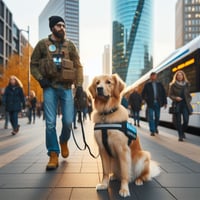In a world where the incredible bond between humans and dogs goes beyond companionship, service...
How to Use Food to Build Structure, Loyalty, Obedience, and Engagement with Your Dog

Food isn’t just fuel—it’s one of the most powerful communication tools you have to train, bond, and lead your dog. Whether you’re raising a puppy, rehabilitating a rescue, or refining the behavior of a high-drive working dog, using food the right way can create lasting loyalty, obedience, structure, and engagement.
In this article, we’ll break down exactly how you can use your dog’s daily meals and treats to become the leader your dog trusts and listens to—without resorting to bribes, frustration, or force.
Table of Contents
Why Food Is the Ultimate Dog Training Tool
Dogs are hardwired to work for resources, and food is one of the most motivating ones out there. In the wild, dogs and wolves hunt or scavenge for every bite. Domesticated dogs still retain that primal wiring—they thrive when food is earned, not just handed over.
🎯 SEO Tip: Training with food reinforces your role as a provider, leader, and source of direction—not just a vending machine.
Benefits of using food in training include:
-
Faster learning through positive reinforcement
-
Reduced anxiety due to predictable structure
-
Stronger engagement and focus on the handler
-
Improved bond and trust
Structure Starts with the Bowl
If your dog has free access to a full bowl 24/7, you're missing a major training opportunity.
Set Feeding Windows
-
Feed twice a day (morning and evening) at consistent times.
-
Give your dog 10–15 minutes to eat, then remove the bowl.
This creates routine and predictability, which reduces stress and builds trust.
Controlled Feeding = Controlled Mindset
Ask for a simple behavior before giving food, like:
-
Sit and wait
-
Eye contact
-
Going to their place
These micro-rituals condition your dog to listen before receiving, a cornerstone of respectful obedience.
📌 Example: “Sit, then bowl goes down.” If the dog breaks the sit, the bowl goes up and you try again. This builds impulse control.
Building Loyalty Through Consistent Feeding Rituals
Dogs form loyalty to those who meet their needs consistently—and that starts with food.
Use Meals to Build the Bond
-
Hand-feed portions of meals to shy or fearful dogs
-
Use meals during training walks instead of treats
-
Feed from a treat pouch or training belt so your dog orients to you
Dogs are loyal to handlers who make food meaningful, not just accessible. They begin to see you as the source of good things, especially when food comes through calm, clear guidance.
🐾 Dogs rescued from neglectful or chaotic homes especially benefit from reliable, structured meal routines. It rebuilds trust and safety.
Using Food to Reinforce Obedience
Don’t just use food to teach tricks—use it to build foundational obedience that translates to real life.
High-Frequency Rewarding for New Behaviors
-
Use rapid fire treat sessions when teaching a new behavior like heel, down, or recall.
-
Mark behaviors with a clicker or word like “yes” before giving food.
Variable Rewarding to Strengthen Behavior
Once your dog knows a behavior, switch to randomized rewards to make the behavior stronger and more reliable.
Example:
-
Ask for a sit 5 times. Reward on reps 1, 3, and 5.
-
This keeps your dog engaged and guessing, just like slot machine psychology.
Boosting Engagement with Food-Based Games
Food is also an incredible tool for building drive and focus through play.
Engagement Games to Try:
-
Find It Game: Toss kibble in grass or a snuffle mat to boost scentwork skills
-
Catch and Chase: Toss a treat slightly behind your dog and cue them to find it
-
Food Recall: Have a partner hold your dog, call them with “come!” and reward with a high-value treat when they sprint to you
🧠 Pro Tip: Use part of your dog’s meal for these games to prevent overfeeding and increase the value of mealtime.
Common Mistakes to Avoid
🚫 Using food as a bribe
If the dog only listens when food is visible, you’re not reinforcing behavior—you’re buying it. Instead, hide the food, use a marker like “yes,” then reward after.
🚫 Inconsistency in timing
Don’t reward too late or too soon. Use clean timing to mark the exact moment the dog completes the desired behavior.
🚫 Overfeeding
Adjust meal portions if you’re using a lot of food in training. Obesity causes long-term health issues and lowers energy.
🚫 Feeding under stress
If your dog is too anxious to eat, back up, lower the intensity, and rebuild the routine in a calm environment.
Final Thoughts: Make Every Meal Count
When used with intention, food becomes more than just calories—it’s a training tool, a relationship-builder, and a life-shaping motivator. Dogs that eat with purpose become calmer, more responsive, and more loyal.
At Social Dogs, LLC, we specialize in helping dog owners turn everyday moments—like feeding time—into opportunities for leadership and connection. Whether you’re raising a high-drive pup or a rescue dog with baggage, we’ll help you build a bond that lasts.
📩 Want more training tips in your inbox? Sign up for our free newsletter at socialdogsllc.com
.png?width=50&height=50&name=Profile%20round%20logo%20(1).png)



